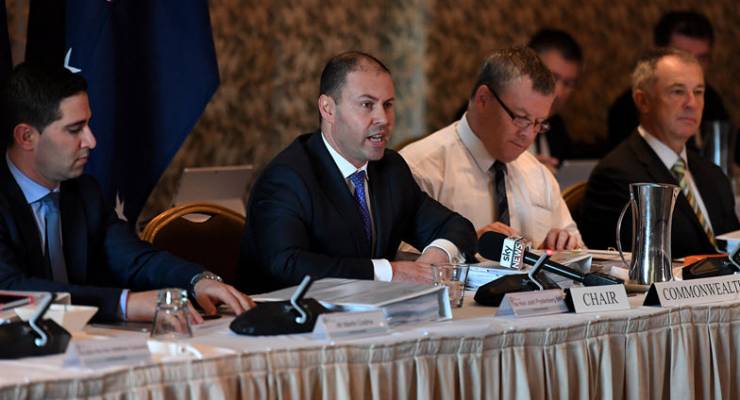
Federal Energy Minister Josh Frydenberg at today’s COAG Energy Council meeting.
Imagine if petrol prices went up from $1.29/litre to $180/litre for brief parts of the day on a few days of the year. Worse still, imagine drivers had no way of knowing what price they were paying until after they’d filled up.
If that was the case, Australia’s energy ministers meeting in Brisbane today would have ways to help drivers avoid the price spike at the top of the agenda. Thankfully, this doesn’t happen with petrol, but essentially this is what happens with electricity in Australia.
Evening out electricity price spikes and helping electricity users avoid them should be the main game at the energy talks today and Shane Rattenbury, the ACT Minister for Climate Change and Sustainability will give the other seven ministers a new report by The Australia Institute in which we profile how “aggregated demand response” could work in Australia.
Aggregated demand response is a system where thousands of homes, businesses and factories are linked together by a cloud-based computer system into what the CSIRO calls a “virtual” power plant. Rather than generating electricity when supply is short, a virtual power plant turns down energy-consuming devices, to restore balance to the grid and keep the lights on. Instead of building more infrastructure to deliver excess megawatts we can deliver “negawatts” of energy savings.
(In strict economic terms, demand response is designed to improve the allocative efficiency of energy markets. There are other efficiency measures — such as passive solar building design and appliance standards — which are designed to reduce the overall amount of energy consumed.)
After South Australia had a blackout last year, governments proposed to build new generators to improve security. Prime Minister Malcolm Turnbull commissioned a study into a multibillion-dollar upgrade to the Snowy Mountains hydroelectric scheme. The study and review process alone is likely to take years to complete.
According to the Australian Energy Market Operator’s CEO Audrey Zibelman the lights should stay on this summer, but AEMO also confirms that there is a risk of energy shortfalls in New South Wales, Victoria and South Australia.
The conventional solution to the risk of energy scarcity is to build new generators and increase the carrying capacity of the grid — the notorious “gold plating” that Energy Minister Josh Frydenberg rails against. The old energy industry is like the proverbial man with a hammer, to whom everything looks like a nail.
Dr Alan Pears AM has argued for many years that efficiency is the elegant solution that gives governments the easiest energy (and therefore climate) policy wins. In his submission to the Finkel Review he wrote, “Energy efficiency is core to energy and energy market policy: it drives the amount, timing and quality of the energy required”.
The negawatts answer to energy security is to make demand controllable, so it can respond to high prices and grid congestion. One of benefits of this approach is that it does not involve building large, centralised infrastructure. It simply repurposes existing assets, owned by private companies or households, ranging from massive factory smelters through to commercial cool-stores and even domestic air-conditioners.
How it works is that an aggregator company installs controllers onto the consumer devices and links these to its control software. Consider the example of a large commercial cool store full of food that has to be kept below 4 degrees. AEMO forecasts that there will be a heatwave tomorrow and an energy shortage for half an hour at 5pm and the aggregator kicks into action.
On the next day, at 4pm, while electricity is around the average of $100 per MWh, the aggregator software takes remote control of the cool store and pre-chills it down to 2 degrees. Then at 5pm, when the price of electricity rockets up to the regulatory limit of $14,000, the fridge is turned off. The insulation keeps everything cool enough until the price peak passes and the refrigeration compressors are turned back on.
The aggregator has saved an electricity bill increase of $14,000, at almost no cost. This profit is then split between the aggregator and the energy consumer. The grid benefits from lower congestion, lower wholesale peak prices and less chance of a blackout.
What makes this system so politically powerful is that it means households can also participate in lucrative energy markets. There are already 1.6 million households with solar PV and four in five of these are keen on installing batteries, according to polling by The Australia Institute.
Reposit, an Australian startup, is already paying its customers “GridCredits” for using their batteries to boost supply. This makes money for the household and has no impact on their comfort at home.
The International Energy Agency benchmark is that demand response can deliver around 15% of peak demand but we have less than 1% of demand response operating. The demand response sector is forecast to grow almost four-fold by 2025, to be worth US$36 billion and producing 144 GW negawatts of avoided energy waste.
COAG has been deliberating this issue for 15 years. In 2002, the Parer Review recommended opening up the electricity market so that energy efficiency negawatts could compete with more expensive — and polluting — generation megawatts.
One of the key market reforms that is required is to move to faster markets, as recommended by the International Energy Agency. The Australia Institute has made submissions to the Australian Energy Market Commission and the Climate Change Authority, in favour of the Five Minute Settlement Rule and reforms to enable demand response.
My view is that modernising energy markets, and opening them up to competition from new, clean energy and energy efficiency technologies is the way that Frydenberg can have a big win in both the energy and environment sides of his portfolio.
In 2017, it is time to put energy efficiency reform at the top of the agenda. Australia’s energy ministers need to cut the kvetching and get with the program.
*Dan Cass is a strategist at The Australia Institute — @DanJCass








The system is a rehash of an old solution to the opposite problem, when an oversupply in electricity causes the price to go low or negative. That should be the opportunity for everyone with a battery to store it up and sell later when the prices high. These are the “intermittent consumers” needed for an intermittent energy supply. However the biggest batteries are not big enough and despite recent hype, show little likelihood of reaching the grid-scale capacity needed.
Industrial society has developed in, and continues to be designed for, a steady price for a reliable supply. Why should this broader consumer base offer from wild fluctuations of electricity caused by intermittent supply? It would make sense for these (purportedly willing and able) intermittent consumers to do their own private deal with the intermittent suppliers for a mutual profit. It would relieve the pressure on the grid operator, allowing it to provide the remaining dispatchable power to on-demand consumers.
Surely Dan this is the result of privatisation. A Mw/h of electricity has little variation in the cost of production and that is entirely source related. The present system actually encourages power suppliers to hold off producing power to maximise the price as we saw last summer, with the power stations in SA offline at critical times for “technical reasons”-read greed or malfeasance.
Agree totally with you Greybearded One. Greed or malfeasance definitely. The situation is disgusting.
Thanks OGO. You are correct that privatisation has failed to acheive efficiency and of course has embedded the old, polluting model.
But I note that detailed research by Dr Bruce Mountain indicates that you can have good or bad outcomes from both privatised or state-owned electricity industries.
In Australia for example, state governments (and the feds via the Snoty) still own hefty investments in generators and poles and wires. The problem here is that they milk these investments for returns or try to make them richer pickings for future privatisation rounds, rather than use them wisely to keep prices down and transition to a low emissions, democratic energy system.
Gaming of markets is a key driver of higher prices, which is why we advocate the Five Minute Rule: https://uat.crikey.com.au/2017/04/05/the-five-minute-solution-to-australias-energy-crisis/
What an over-response to gaming by generators – and to excessive depreciation allowances. Just fix the real problems.
Josh can go and GF. I spent a lot of my own money putting panels up, to reduce my bills and it hasn’t happened because his lot c=keep fusing prices up. I feel really sorry for those that cant afford to add solar, it should be something that our feds are pushing, but they would rather pump billions of subsidises into fossil fuel crap…3.3 billion to renewable , 11 billion to fossil fuel…kill subsidies to everything now.
Am I going made or is the first paragraph categorically false?
Electricity retailers are exposed to price fluctuations, but consumers are not. Sure the price has trended up as a result of the spot market price spikes, but customers are not exposed to that volatility in any way equivalent to the analogy in the first paragraph.
Good question Jimmy, thanks.
Indeed, its an analogy, not a description, but a useful one.
The point is that the price you and all of us customers do pay for the total cost of electricity supplied to us through our bill, including the peaky times.
For example, the Productivity Commission reported that 40 hours of price peaks in NSW made up 25% of annual cost of electricity.
Your retailer might be really lovely, but I can assure you, if their input costs go up, they pass it on! Its not reflected in an hourly or daily change to your bill, but the bill will go up, without fail.